#Sphaerotholus
Explore tagged Tumblr posts
Text
Sphaerotholus triregnum Woodruff et al., 2023 (new species)
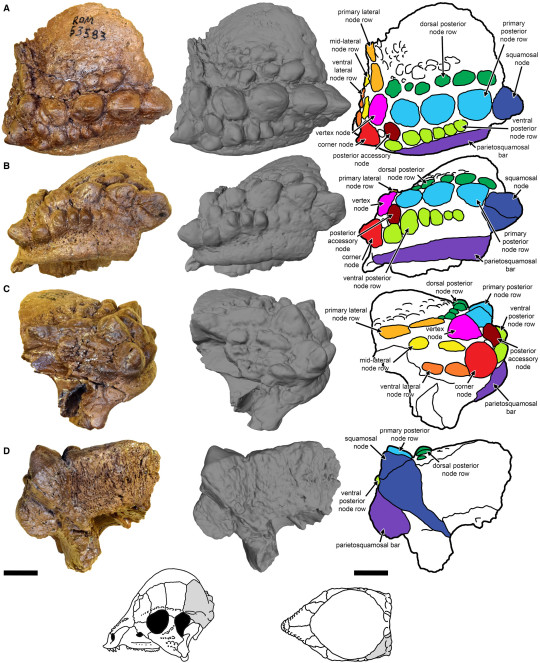
(Type squamosal [bone in the back of the skull] of Sphaerotholus triregnum [scale bars = 1 cm], from Woodruff et al., 2023)
Meaning of name: triregnum = triregnum [a domed, three-crowned ceremonial head piece worn by popes of the Catholic Church during the 14th Century]
Age: Late Cretaceous (Maastrichtian), between 66.9–67.2 million years ago
Where found: Hell Creek Formation, Montana, U.S.A.
How much is known: A nearly complete left squamosal (one of the bones in the back of the skull).
Notes: S. triregnum was a pachycephalosaur, a group of herbivorous dinosaurs famous for their thickened, domed skull. Three other species of Sphaerotholus had previously been named, S. goodwini from the Kirtland Formation of New Mexico; S. buchholtzae, also from the Hell Creek Formation, as well as the Frenchman Formation of Saskatchewan; and S. edmontonensis from the Horseshoe Canyon Formation of Alberta.
Despite being very incompletely known, S. triregnum can be distinguished from S. goodwini and S. buchholtzae in having three rows of bony bumps along the back of the squamosal, instead of only one. Squamosals have not been found for S. edmontonensis, but it had a distinctive character in that one of the bumps on the adjacent parietal bone would have also been partly formed by the squamosal (a feature found in S. buchholtzae as well), whereas the equivalent bump in S. triregnum originates from the squamosal alone.
Although some pachycephalosaurs (including S. buchholtzae) appear to have undergone dramatic changes in skull shape during growth, the arrangement of the numerous small bumps in the back of their heads seems to have remained fairly stable throughout their lifetimes, and is thus considered a reliable feature for identifying distinct species. Along with the also newly-named S. lyonsi from the Dinosaur Park Formation of Alberta, S. triregnum indicates that small pachycephalosaurs were likely more diverse than previously appreciated, even in well-studied Late Cretaceous fossil sites of North America.
Reference: Woodruff, D.C., R.K. Schott, and D.C. Evans. 2023. Two new species of small-bodied pachycephalosaurine (Dinosauria, Marginocephalia) from the uppermost Cretaceous of North America suggest hidden diversity in well-sampled formations. Papers in Palaeontology 9: e1535. doi: 10.1002/spp2.1535
#Palaeoblr#Dinosaurs#Sphaerotholus triregnum#Late Cretaceous#North America#Pachycephalosauria#2023#Extinct
44 notes
·
View notes
Text
To warm up before the tournament itself, and to help me a little with bracket making:
Please reblog for a larger sample size, and follow if you haven't already and would like to participate!
#dinosaurs#dinosaur#poll#polls#saurnament#IT WAS VERY HARD TO GROUP AS MANY AS POSSIBLE TOGETHER IN 12 OPTIONS OKAY#is it obvious that this list became increasingly less scientific as i realized i only had 12 slots lol#reblog please#a large sample size would be great#going to be a little embarrassing if not many people see this#but hopefully enough people do that i get a good idea of how to matchmake
444 notes
·
View notes
Text

artwork by @thewoodparable
127 notes
·
View notes
Text
Two new species of small-bodied pachycephalosaurine (Dinosauria, Marginocephalia) from the uppermost Cretaceous of North America suggest hidden diversity in well-sampled formations
Published 16th November 2023
Two new small-bodied pachycephalosaurines, Sphaerotholus lyonsi and Sphaerotholus triregnum, are discovered: one from the Dinosaur Park Formation in Alberta and the other from the Hell Creek Formation in Montana, both represented by an isolated squamosal.

Holotype left squamosal of Sphaerotholus triregnum

Holotype left squamosal of Sphaerotholus triregnum
Source:
23 notes
·
View notes
Note
wonderful to see you again Shelly Fossilian! did you know, you reignited my love for dinosaurs? you always told a bunch of amazing dinosaur facts, and there's been quite a few discoveries you may not have heard about! a lot of folks have been thinking about you and wanting to get to know you again, not just me. that's kinda like how dinosaurs went isn't it? it feels like the world forgot them for a while, but some people found them after they were lost deep down and people wanted to learn about them and remind the world about them... so let's catch up Shelly! even if this twisted thing makes you forget, I'll write it down and tell you again if you want! *proceeds to go on a passionate description of dinosaurs discovered in 2002 and beyond like Anabisetia, Erliansaurus, Sphaerotholus (a cool 2024 dinosaur is a Lokiceratops, and a 2025 is Duonychus!)*
Oh uh... Yeah, I think you lead her away.. finally.. I can leave this corner..
#dandys world#dw#boxten#dw boxten#boxten dw#dandy's world boxten#roleplay blog#dandy's world rp#rp blog#ask blog
1 note
·
View note
Text
I paleontologi scoprono due nuove specie di dinosauri pachicefalosaurici
Sphaerotholus buchholtzae (specie più piccola) in lotta con i pachicefali più grandi, Formazione Hell Creek, Montana, Stati Uniti. I paleontologi hanno portato alla luce i resti fossilizzati di due nuovi pachicefalosauri di piccola taglia: uno nella Formazione Dinosaur Park dell’Alberta e l’altro nella Formazione Hell Creek del Montana. Una delle nuove specie di dinosauro, chiamata…
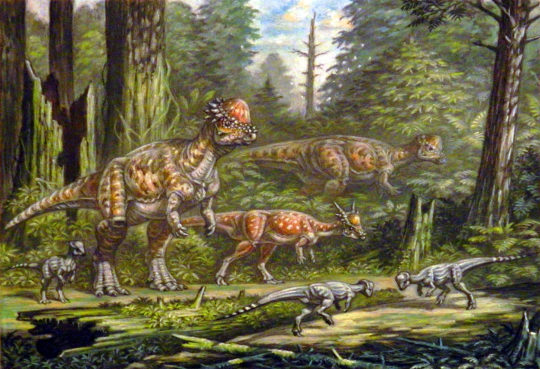
View On WordPress
0 notes
Photo

Hey! Here comes another dino but this one is little bit smaller He is very hard headed and does not get scared that easily >:3 It’s another piece I made when I was bored with my friend We again picked some random dino and colors and used them to see what we can create Maybe I will draw some other dinos in the future We shall see Anyway hope you enjoy this little guy ;) See ya soon
#Sphaerotholus#dinosaur#dino#Pachycephalosauridae#Sphaerotholus goodwini#digital art#digital#pachycephalosaurus#pachy#small#prehistoric#animal#lizard#herbivore#art
11 notes
·
View notes
Photo

Hide and seek by tuomaskoivurinne
The tread of a predator builds a rhythm in the woods, slow, sure, menacing. Each footfall sounds the weight of the beast, but also the crackle of leaf litter and dried twigs, and the gentle muffling of weeds pressed into the mud. The birds are still, but they chirp nervous notes every few seconds, as if they cannot help but express the moment. Once the tyrannosaur is gone, they hop about, dip bills into the creek, perhaps to wash down the tension, and resume more nattering songs. But the pachycephalosaurs remain still. The rhythm yet drums in their ears, and the smell of the predator’s breath—rank from old blood and a rotten tooth—still burns their noses. So, they lay like stones beside the log, daring the moss to grow on them.
100 notes
·
View notes
Photo

I wasn't going to post this, but... here it is. Sphaerotholus Goodwini I barely found something about this dino, he’s pretty obscure. My inspiration for the coloring was Homalocephale from JPOG, i love that tiny dino.
4 notes
·
View notes
Text
It Came From The Wastebasket #10: Struggling With Stegoceras
First described and named in the early 1900s, Stegoceras validum was a dog-sized small pachycephalosaur that lived in Alberta, Canada, during the Late Cretaceous (~77-74 million years ago).
Initially just known from its skull domes, it was one of the first pachycephalosaurs to be discovered and was very poorly understood until more complete remains were found in the 1920s. Then it spent a couple of decades being mixed up with Troodon due to similarities in tooth shape, until the discovery of Pachycephalosaurus led to pachycephalosaurs finally being recognized as a distinct group of ornithischian dinosaurs in the 1940s.
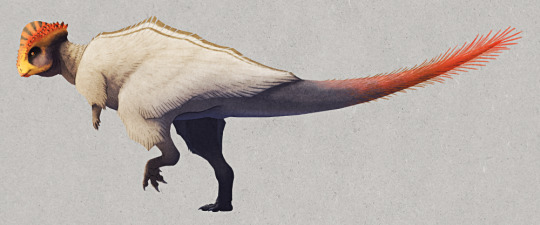
For much of the 20th century Stegoceras was treated as a wastebasket taxon for any small-to-mid-sized North American (and one Asian) pachycephalosaur, and multiple different species were named based on what were often rather dubious fragmentary fossils. But towards the start of the 21st century this mess did start getting cleaned up, merging some dubious species into the original Stegoceras validum, and moving others to separate genera like Sphaerotholus, Colepiocephale, Hanssuesia, and Sinocephale.
By the early 2000s just the Canadian Stegoceras validum remained – but then in 2011 the new species Stegoceras novomexicanum was named based on specimens from New Mexico, USA. The validity of this second species has been debated, since the fossils are juveniles and might instead belong to Stegoceras validum or another genus like Sphaerotholus, but if it is some sort of Stegoceras then it significantly re-extends the known geographic range of this little pachycephalosaur.
———
Nix Illustration | Tumblr | Twitter | Patreon
#it came from the wastebasket#wastebasket taxon#taxonomy#stegoceras#pachycephalosaur#ornithischia#dinosaur#paleontology#art#science illustration#paleoart#palaeoblr
233 notes
·
View notes
Text
Sphaerotholus lyonsi Woodruff et al., 2023 (new species)
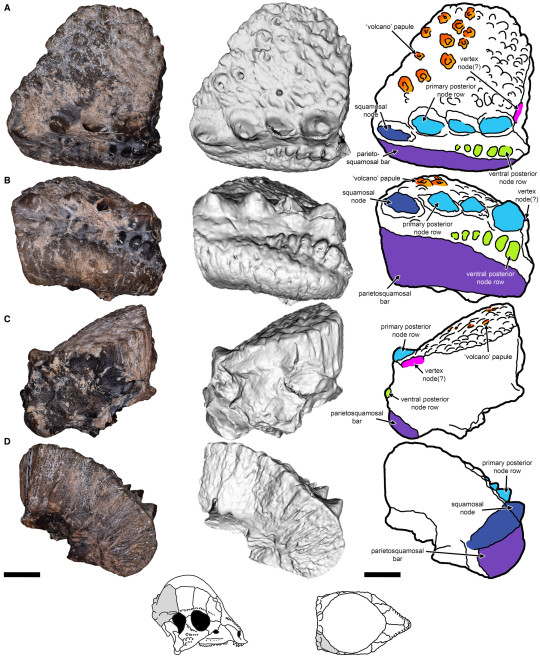
(Type squamosal [bone in the back of the skull] of Sphaerotholus lyonsi [scale bars = 1 cm], from Woodruff et al., 2023)
Meaning of name: lyonsi = for Randy Lyons [discoverer of the original fossil]
Age: Late Cretaceous (Campanian), about 76.1 million years ago
Where found: Dinosaur Park Formation, Alberta, Canada
How much is known: A nearly complete right squamosal (one of the bones in the back of the skull).
Notes: S. lyonsi was a pachycephalosaur, a group of herbivorous dinosaurs famous for their thickened, domed skull. Three other species of Sphaerotholus had previously been named, S. goodwini from the Kirtland Formation of New Mexico, S. buchholtzae from the Hell Creek Formation of Montana and the Frenchman Formation of Saskatchewan, and S. edmontonensis from the Horseshoe Canyon Formation of Alberta.
Despite being very incompletely known, S. lyonsi can be distinguished from S. goodwini and S. buchholtzae in having two rows of bony bumps along the back of the squamosal, instead of only one. Squamosals have not been found for S. edmontonensis, but it had a distinctive character in that one of the bumps on the adjacent parietal bone would have also been partly formed by the squamosal (a feature found in S. buchholtzae as well), whereas the equivalent bump in S. lyonsi originates from the squamosal alone.
Although some pachycephalosaurs (including S. buchholtzae) appear to have undergone dramatic changes in skull shape during growth, the arrangement of the numerous small bumps in the back of their heads seems to have remained fairly stable throughout their lifetimes, and is thus considered a reliable feature for identifying distinct species. Along with the also newly-named S. triregnum from the Hell Creek Formation, S. lyonsi indicates that small pachycephalosaurs were likely more diverse than previously appreciated, even in well-studied Late Cretaceous fossil sites of North America.
Reference: Woodruff, D.C., R.K. Schott, and D.C. Evans. 2023. Two new species of small-bodied pachycephalosaurine (Dinosauria, Marginocephalia) from the uppermost Cretaceous of North America suggest hidden diversity in well-sampled formations. Papers in Palaeontology 9: e1535. doi: 10.1002/spp2.1535
#Palaeoblr#Dinosaurs#Sphaerotholus lyonsi#Late Cretaceous#North America#Pachycephalosauria#2023#Extinct
22 notes
·
View notes
Photo
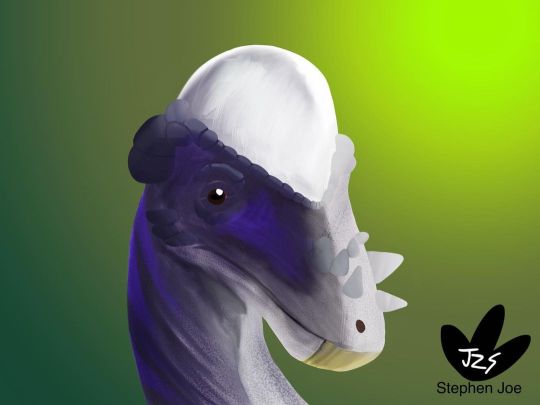
Day 25: Pachycephalosaurus Pachycephalosaurus wyomingensis is a last non-avian pachycephalosaurid, along with small relatives of Sphaerotholus. #Dinovember #Dinovember2022 #paleoart #sketchbookapp #myart #pachycephalosaurus #pachycephalosauruswyomingensis #pachycephalosauridae #pachycephalosauria #marginocephalia #ornithischia #dinosauria #dinosaur https://www.instagram.com/p/ClZp5Q_rXg5/?igshid=NGJjMDIxMWI=
#dinovember#dinovember2022#paleoart#sketchbookapp#myart#pachycephalosaurus#pachycephalosauruswyomingensis#pachycephalosauridae#pachycephalosauria#marginocephalia#ornithischia#dinosauria#dinosaur
24 notes
·
View notes
Text
Round Two: Changmiania vs Sinocephale
Changmiania liaoningensis

Artwork by @i-draws-dinosaurs, written by @zygodactylus
Name Meaning: Eternal Sleeper from Liaoning
Time: 125.755 million years ago (Barremian stage of the Early Cretaceous)
Location: Lujiatun Beds, Yixian Formation, Liaoning, China
Changmiania is a gorgeously preserved ornithopod known from the earliest time of the famed Yixian Formation, adding it to the ranks of amazing fossils known from this unique preservational environment. The multiple specimens of this species are found in sleeping poses, curled up on the ground with their legs and arms tucked up against them. This indicates they had been buried alive, possibly inside their own burrows. Given the depositional environment of Yixian is a sort of prehistoric Pompeii, with many dinosaurs covered very quickly in ash and dust from an exploding volcano, this makes a certain degree of sense - perhaps the two little dinosaurs had scurried into their burrow to escape the oncoming tragedy (sorry if I just made you sad), or had been asleep and unaware of the oncoming danger. At only one meter long and less than half a meter tall, Changmiania would have been easily missed in its environment, hiding among the dense vegetation from potential predators. With robust leg bones, it would have been a fast runner, able to move efficiently through the crowded undergrowth. It had a weirdly short neck for ornithischians, and that combined with its short forearms and hands indicates it was fossorial - ie, a digging animal, hence its burrow home and final resting place. Given they were found together, they were probably social creatures as well, living in small family groups. The Yixian was a dense temperate forest, filled with freshwater lakes and a great diversity of plantlife. Conifers, ferns, cycads, horsetails, and early flowering plants filled the environment and indicated a humid, possibly rainforest environment. Periodic wildfires, noxious lake gasses, and volcanic eruptions all lead to regular moments of rapid burial and amazing preservation in this environment - essentially giving us snapshots of how it changed over the course of many millions of years. In the Lujiatun bed specifically, Changmiania was neighbors with Euhelopus, Jeholosaurus, Liaoceratops, Psittacosaurus, Liaoningornis, Daliansaurus, Graciliraptor, Mei, Sinovenator, Sinusonasus, Dilong, Hexing, Incisivosaurus, Shenzhousaurus, and outside of dinosaurs mammals such as Acristatherium, Gobiconodon, Juchilestes, Maotherium, Meemannodon, and Repenomamus (yes, THAT Repenomamus), and the toad Liaobatrachus.
Sinocephale bexelli
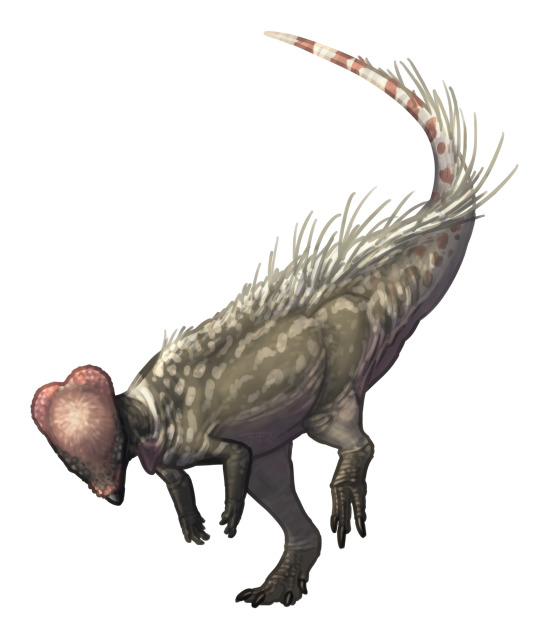
Artwork by @i-draws-dinosaurs, written by @zygodactylus
Name Meaning: Bexel’s Chinese Head
Time: 92 million years ago (Cenomanian stage of the Late Cretaceous)
Location: Ulansuhai Formation, Inner Mongolia, China
Sinocephale is an interesting case of a previously named dinosaur being renamed - and then given a new one altogether! Though originally discovered in the early 20th century and lumped into Troodon (pachycephalosaurs used to be considered Troodontids, don’t worry about it), and then shoved into Stegoceras when that whole nonsense got fixed. Unfortunately, Sinocephale really doesn’t resemble Stegoceras much at all! Shoved into dubious or not properly named genera for the petter part of multiple decades, it was only recently that it was studied and raised as a holotype for a new genus - Sinocephale! As a pachycephalosaur, it was a small bipedal animal, with a weirdly hyper-stiffened tail, and a dome on its head. Interestingly for Sinocephale, that dome was shaped like a heart (from above)! This is the distinct trait that distinguishes Sinocephale from its relatives. It was not closely related to Stegoceras at all, but closer to Sphaerotholus and the Pachycephalosaurus group. While Sinocephale lived in a somewhat poorly understood geological formation, we do know it lived alongside other dinosaurs such as Shaochilong, Sinornithomimus, and Chilantaisaurus, as well as some turtles.
#dmm#dinosaur march madness#dinosaurs#birds#dmm rising stars#dmm round two#birblr#palaeoblr#paleontology#bracket#march madness#polls#changmiania#sinocephale
82 notes
·
View notes
Note
The Yellow Pachycephalosaur from Dinosaur Revolution is Sphaerotholus buchholtzae, right? The episode it was featured in (End Game) is set 66 MYA in North America, specifically the Hell Creek Formation. Stegoceras is extinct at this point & it doesn't resemble any of the other Pachycephalosaurs around at the time (i.e. Dracorex, Stygimoloch & Pachycephalosaurus). Therefore, it can only be Sphaerotholus buchholtzae?
The pachycephalosaur in Dinosaur Revolution was modeled after Prenocephale, but it was repurposed for the Hell Creek episode after the Prenocephale story got cut from the series. So it wasn’t originally intended to be any Hell Creek pachycephalosaur at all, and in my experience those who worked on the show generally refrain from identifying it as a specific pachycephalosaur genus. You could probably get away with headcanoning it as Sphaerotholus if you wanted to though.
1 note
·
View note
Text
Dinoetae AU Wildlife
Tyrannosaurids: Tyrannosaurus Rex- 14ft tall Dromaeosaurid: Microraptorinae indet- 1ft tall Acheroraptor- 2ft tall Dakotaraptor- 6ft tall Troodontidae: Paronychodon- 2.5ft tall Pectinodon- 3.5 ft tall Coelurosauria: Richardoestesia sp- 4ft tall
Ankylosauria: Denversaurus- 5ft tall Ankylosaurus- 6.5ft tall Ornithomimosauria: Orcomimus- 5ft tall Ornithomimus- 6ft tall Struthiomimus- 7ft tall Sauropoda: Titanosauridae indet- 30ft tall Alamosaurus- 36ft tall Ceratopsia: Leptoceratops- 2.5ft tall Tatankaceratops- 4ft tall Nedoceratops- 11ft tall Triceratops prorsus- 12ft tall Triceratops horridus- 12.5ft tall Torosaurus- 13ft tall
Parksosauridae: Thescelosaurus garbanii- 3ft tall Thescelosaurus neglectus- 5ft tall Parvicursorinae: Trierarchuncus- 2ft tall Ornithomimus minutus- 2.8ft tall Hadrosauridae: Edmontosaurus annectens- 14ft tall Lambeosaur indet- 10ft tall Oviraptorosauria: Caenagnathidae Indeterminate- 5ft Elimisaurine indeterminate- 6ft Anzu- 9ft Pachycephalosauria: Sphaerotholus- 2ft tall Dracorex- 3ft tall Stygimoloch- 4ft tall Pachycephalosaurus- 5ft tall
Azhdarchoidea: Quetzalcoatlus lawsoni- 8ft tall Azhdarchidae spp- 12ft tall Quetzalcoatlus northropi- 16ft tall Pteranodontoidea: Pteranodon longiceps female- 3.2ft tall Geosternbergia female- 3.3ft tall Pteranodontia indet- 4ft tall Pteranodon longiceps male- 5.9ft tall Geosternbergia male- 6ft tall
0 notes
